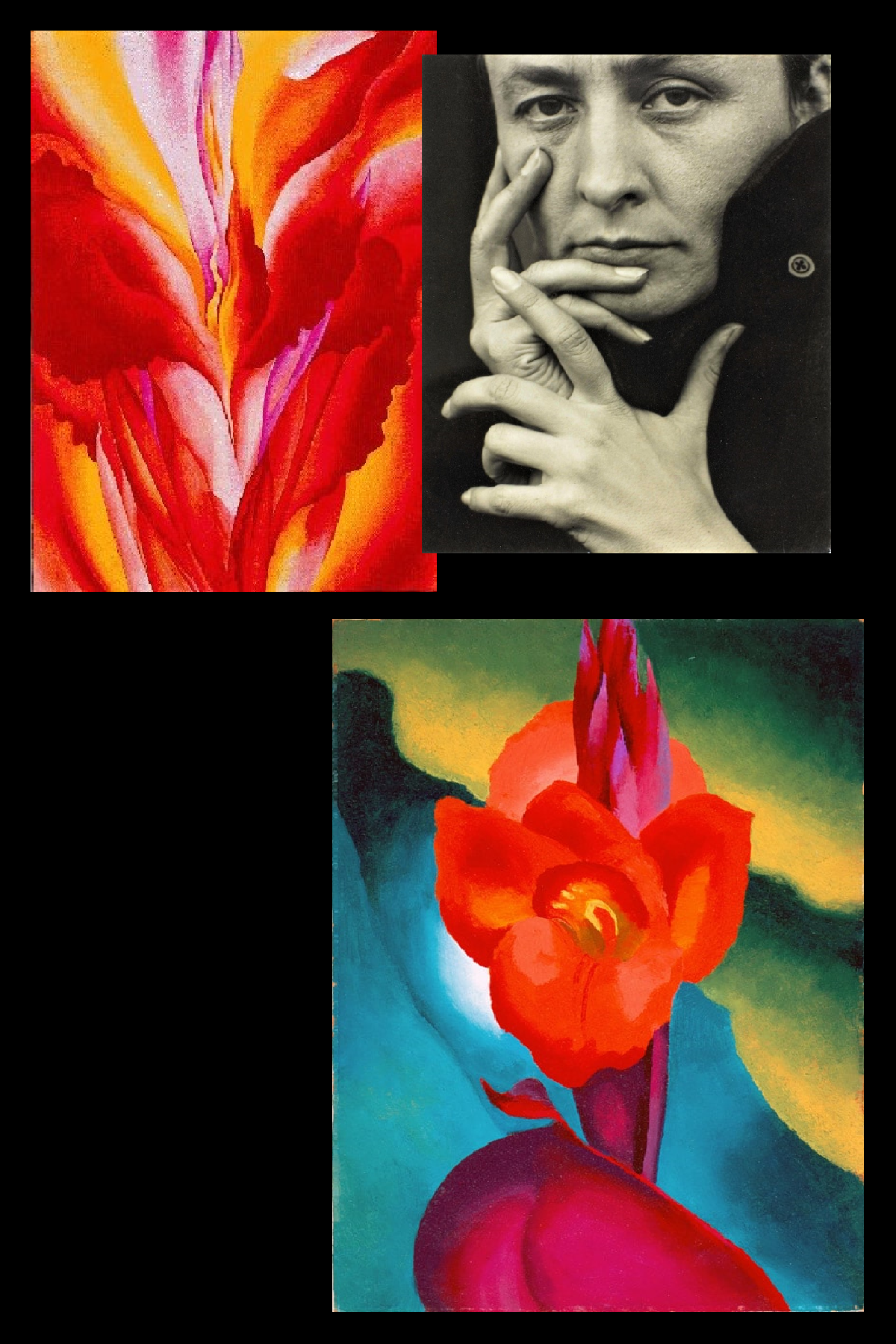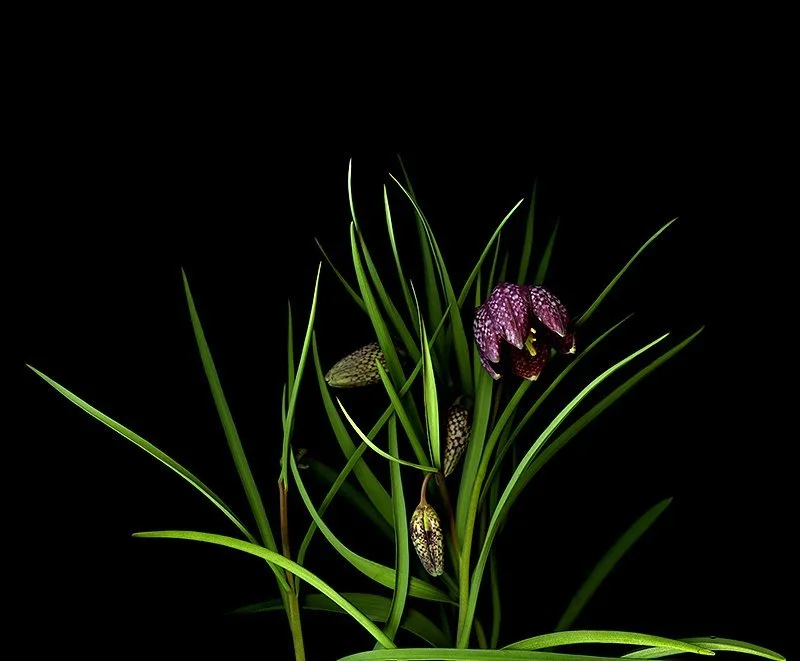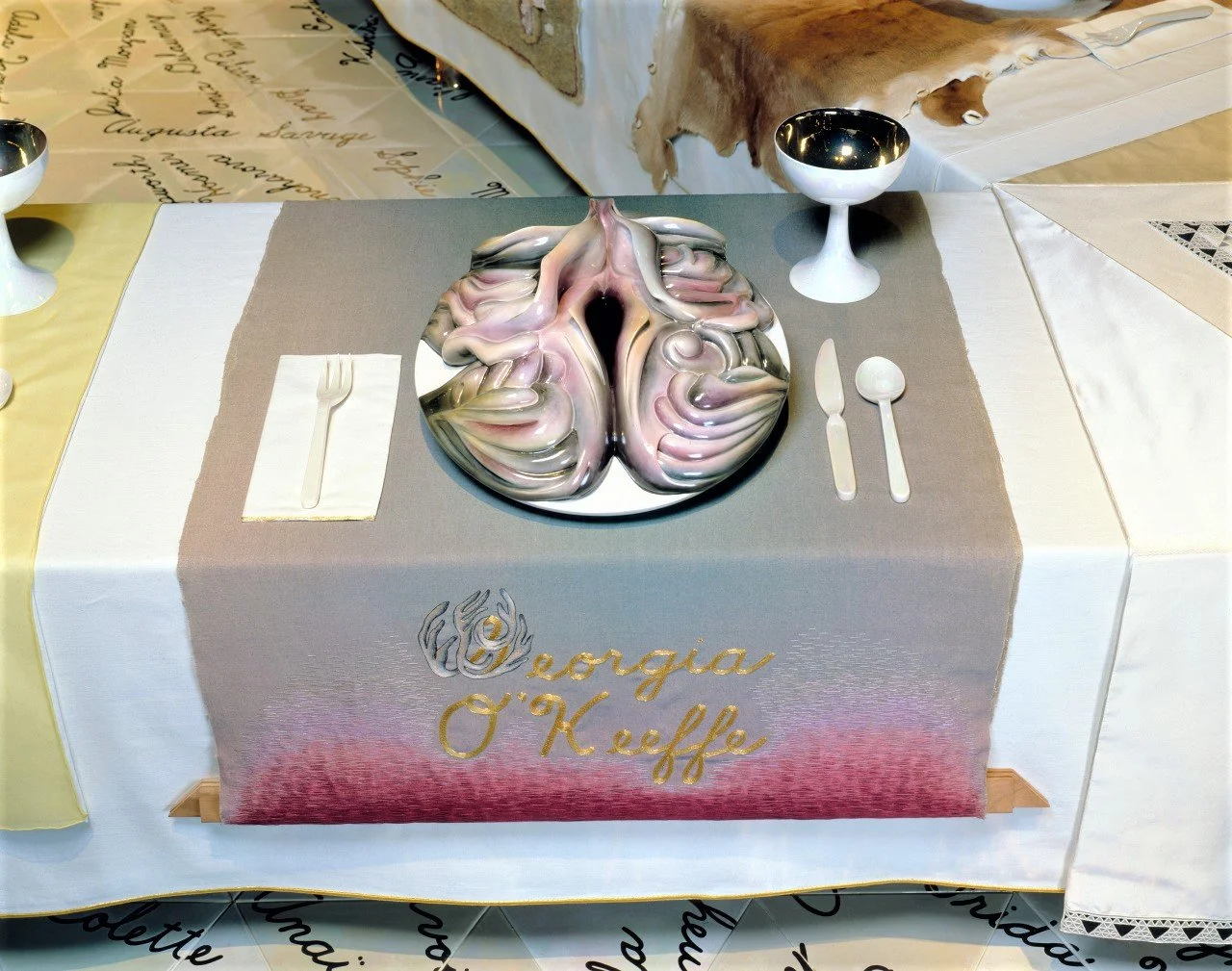O'Keeffe and Chicago: Women's Liberty Not Won and We Are in Danger, Dear Sisters
/Within the context of international women’s rights, burqas, flogging and genital mutilation, the art of Georgia O’Keeffe and Judy Chicago have taken on important new meaning in my life. The art shown in this journal essay would be destroyed at the hands of radical men who want to take away ALL of women’s freedoms today
It’s March, and the natural eroticism of the Carversville landscape is simmering gently out of winter.
Like a woman seeing her husband speaking with a gorgeous stranger at a party, the land shivers with a renewed, thawing sensual excitement. She is caught off guard, as his sameness evaporates in her eyes, and she regards him from afar with renewed interest.
At moments like this, I think of Georgia O’Keeffe; she is my muse, too. I wonder how Judy Chicago is doing; it’s time to see her Dinner Party. I should not be troubled walking along this quiet road in Carversville, confused by the moment I live in. Women’s progress has never been a straight line towards liberation, and yet, I feel danger in this loving land.
My adrenalin alert is not only caused by the battle over burqas. The hate for our new president Barack Obama is ferocious, and I’ve born witness to hideous You Tube videos in the runup to his election. My mind turns to flowers for a delicious escape
Blossoming Scandal
O’Keeffe said about flowers:
“Nobody sees a flower really, it is so small — we haven’t time, and to see takes time like to have a friend takes time.”
This major American artist spent endless hours getting to know her flowers. Her boldly dramatic, yet softly erotic images touch our sensual selves, if we are open to receive them.
There’s a “slow gardening movement” about the land, similar to the “slow food” movement. I agree with O’Keeffe that it’s easy not to see a flower, but that’s a good reason to have only a bloom or two or three. Make them lush flowers like peonies or erotic orchids.
It’s impossible not to see flowers seeped in sensuality, unless passion is dead in you. Such flowers seduce in a deeply erotic language. Take Magda Indigo’s flower photographs. It’s impossible not to succumb to their powerful seduction of our senses. Please enjoy Magda’s spectacular photos at her website. Also on Flickr. )
Feminist Art: What’s That?
Is O’Keeffe a great artist? Does she create feminist art? I leave this discussion to learned types. My own love affair with Georgia O’Keeffe has lived for decades.
I saw the Whitney Museum’s 1970 O’Keeffe retrospective at a time when New York was brilliantly alive with feminism, Max’s Kansas City, and Jimmy Hendrix. She fit right in, although she was the grand dame on my imagination.
The timing of O’Keeffe’s Whitney exhibition was just one year before Linda Nochlin wrote her infamous essay Why have There Been No Great Women Artists?
I remember taking my parents to Max’s upstairs, where a giant piece of conceptual art, a 6 ft breast form lightshow illuminated the scene as were eating dinner. A couple years later, I would have an equally-large breast light show, installed on my living room wall, as the artist was my husband’s brother..
My conservative, Minnesota mother said nothing about Max’s art scene, but I’m sure she was astonished. My father … who knows what he thought. Dad was a pretty sexy guy but he kept quiet in the presence of mama.
Power Percolator
O’Keeffe’s stunningly erotic paintings were not for the timid, but then we were not timid girls in the ‘70s..
Some have argued that O’Keeffe’s “velvet vulvae cum flora may do as much for Woman Power as the 19th Amendment”.
I’m not sure I agree. 30 years after publication of “Our Bodies, Our Selves”, Oprah advised millions of women to get out their mirrors, and take a look “down there”. It was shocking to see how far we hadn’t come in making peace with our own bodies.
Georgia O’Keeffe’s independent, confident style made her one of the boys, writes (The Georgia O;Keeffe Museum)
“She symbolizes the entrancing air of possibility that characterizes the history of women during the twentieth century. Not confined by the conventional pattern of mother and housewife, O’Keefe brings vividly to life not one but several newly perceived female roles.”
Our libertarian was no ordinary muse to husband Alfred Stieglitz. O’Keeffe was strong, mature and independent — never the coquette to the famous photographer, who advanced and promoted her career.
Her iconic power in American culture looms in the erupting scale of her flower passions — so powerful and assertive in their beauty, bold and elegant but only in a Louise Nevelson sort of way.
O’Keeffe achieved personal freedom and authenticity without a hostile rejection of men. In fact, like Ayn Rand’s Dagny Taggart, she often behaved like one of the boys … except when enjoying her sexual freedom with women like Frieda Kahlo.
Desert Peace
Most days, Georgia O’Keeffe lived a seamless, 98-year existence with nature and her beloved New Mexico landscape, far away from the feminist protest marches of New York.
Yet, this brilliantly determined woman was the ultimate feminist, achieving self-realization through her art, living apart from Steiglitz, her husband and her marriage. Deeply in touch with her anthropomorphic sensibilities, O’Keeffe achieved her ultimate love affair with nature, more so than with humans.
In all aspects of her life, this inspiring women sought self-sufficiency, never assuming the role of damsel in distress, never asking for what she hadn’t earned.
A Self-Sustaining Existence
After Stieglitz’s death in 1946, she bought Abiquiu in ruins, turning it into a self-contained, self-sustaining existence, where she grew her own food. Surrounded by friends, she gave great priority to moments alone.
Barbara Rose reminds us that in many ways, the radical nature of Georgia O’Keeffe’s lifestyle and subject matter obscures her artistic originality. I would add that we hold tightly our favorite paintings and never really understand the full scope of O’Keeffe’s artist vision and finished artwork.
The artist’s love of Asian art, Zen Buddhism and photography contribute to an interest in creating lyrical images. Rose writes: “the concentrated poetry in her images recalls the condensed Japanese poetic form of haiku, which says little with little.”
Admittedly, I’ve always been more drawn to O’Keeffe’s flower paintings, than the skull and bone images. Those rose-colored glasses I wear make me a lesser mortal, one not measuring up to O’Keeffe’s insistence that we see nature as unruly and savage, not only sensual and alluring.
Carversville is rarely brutal or vicious. The landscape is unspoiled and unmanicured, but not untamed and primordial like the rugged mountain landscape of Santa Fe. This is as far West as my vision travels, except in business, where you want me in your fox hole.
Looking again at this journal post, I’m intrigued by the similarity of now-added Georgia O’Keeffe’s ‘Grey Hills’, 1941 and the Judy Chicago “Home Sweet Home” place setting, honoring O’Keeffe, featured below.
The undulating, sensual nature of the painting is a ferocious passion held in check or perhaps a tantric orgasm, a rolling, seemingly endless pleasure without a single outburst.
Thirty-seven years after The Whitney O’Keeffe retrospective, this great artist was honored once more in New York, this time in Brooklyn, at the opening of the Judy Chicago’s “The Dinner Party”, now housed in the Elizabeth A. Sackler Center for Feminist Art, at the Brooklyn Museum of Art.
Critics were incited to outrage by individual plates, featuring three-dimensional “vulval” shapes, in honor of 39 famous women in history or mythology, the invited “guests” at Chicago’s dinner party.
This tribute to feminism, and my own historical, coming-of-age roots in New York, is now close at hand, across the Brooklyn Bridge.
Look West Young Woman
Thinking of the New York Harbor, I see another feminist stalwart, perfectly matched to O’Keeffe in her resolute, fearless determination to get it right, and on her terms.
I’ve watched the woman for years now, never flinching, never standing down. Yet, she’s got a lot of heart. Now that’s my kind of woman!
Love, Anne
August 24, 2009. Returning to old posts is a journey all by itself. I’ve seen the Judy Chicago “Dinner Party” installation at the Brooklyn Museum this summer and love its eroticism as a fierce statement about women with backbone.



